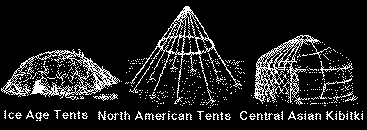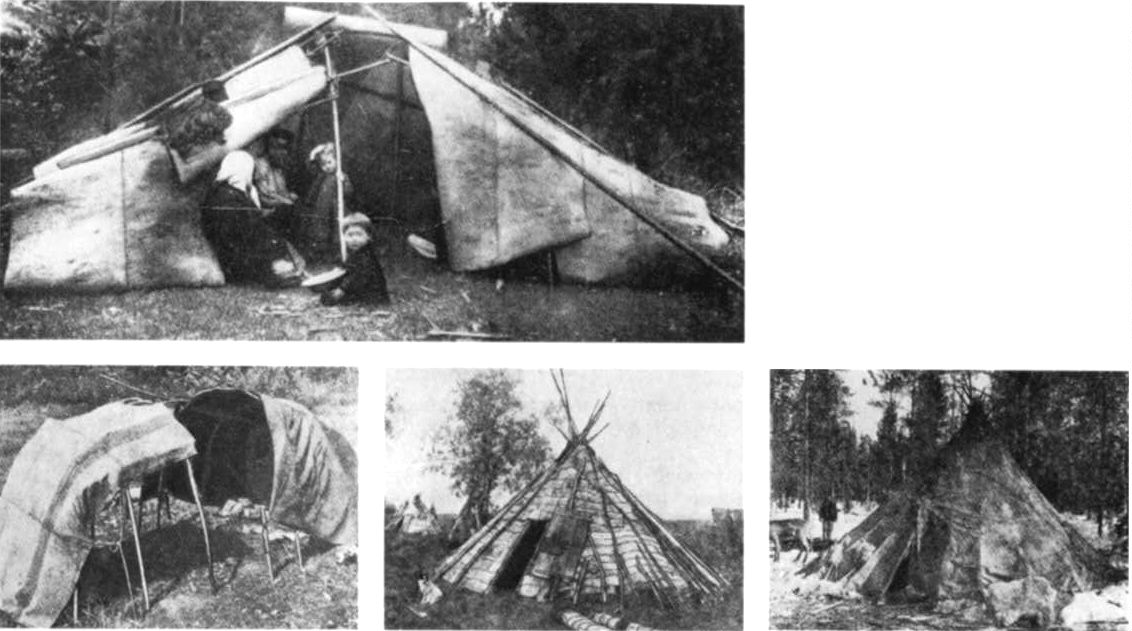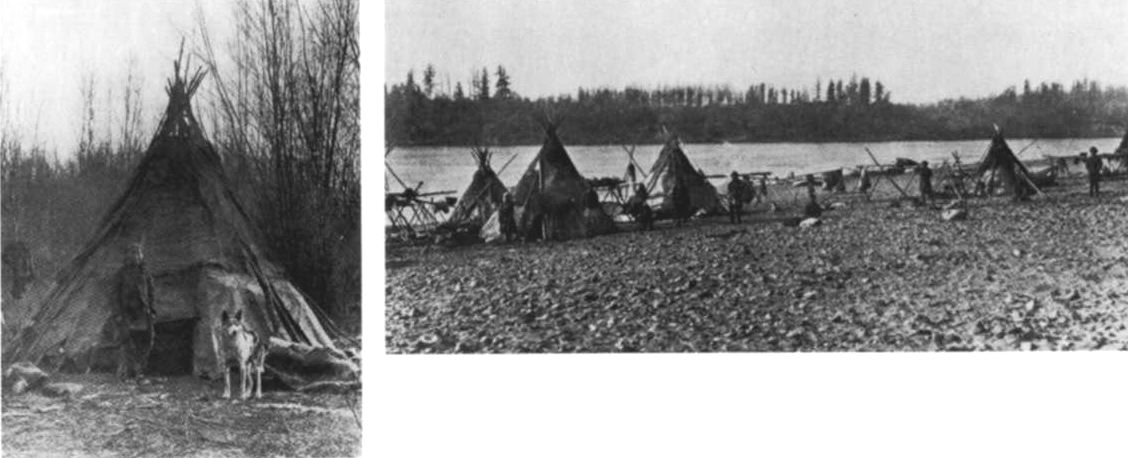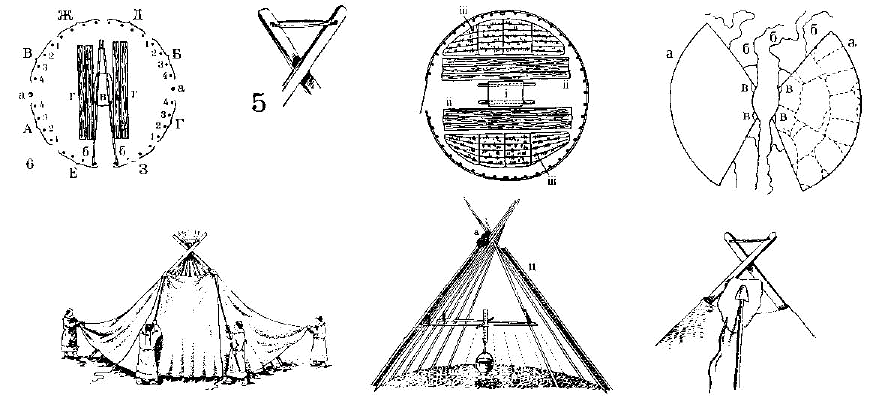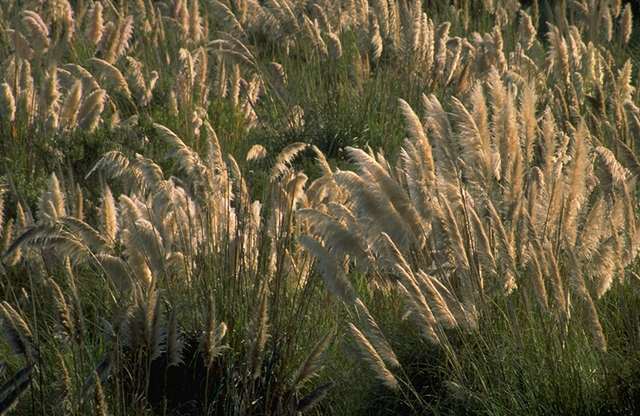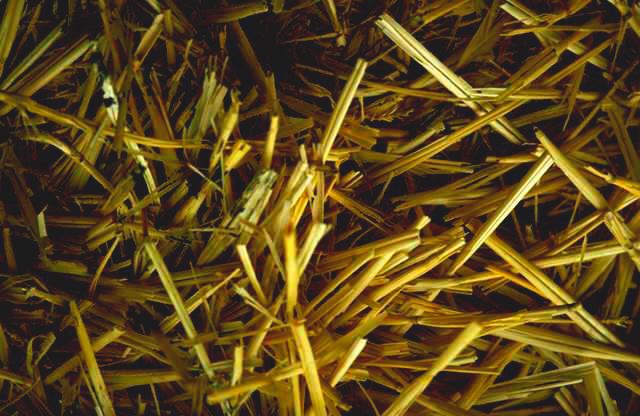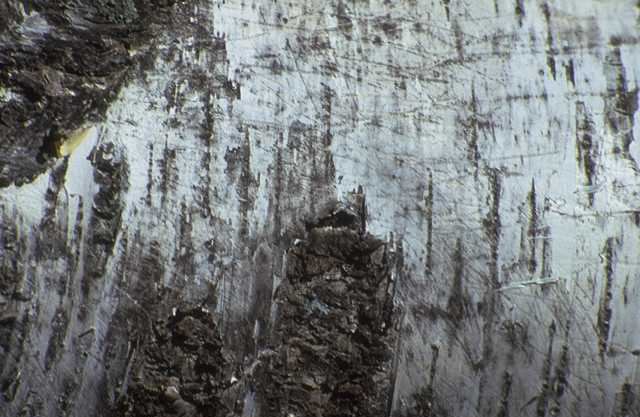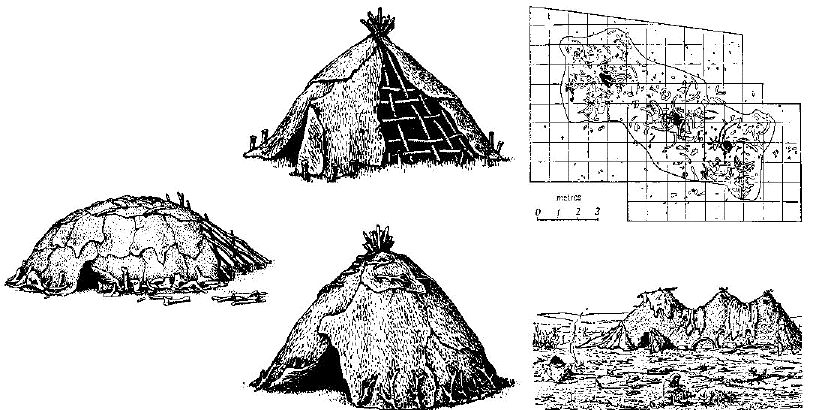 Reconstructions of Ukrainian shelters depict a low domical shape covered
with animal skins and the tent is restrained by heaped mammoth bones.
Later shelters are crude teepees reminiscent of those used by present day
reindeer herders in Northern Asia.
Reconstructions of Ukrainian shelters depict a low domical shape covered
with animal skins and the tent is restrained by heaped mammoth bones.
Later shelters are crude teepees reminiscent of those used by present day
reindeer herders in Northern Asia.
- Mousterian domical shelter comprising a wood frame covered with skins (44,000 years old).
- Upperpaleolithic teepee-like shelter (13,000 years old).
- Tepee-like shelter, 12,000 years old. The skin cover was attached to the wood frame by reindeer antlers.
- Pushkari: Upper Paleolithic earth house: plan & reconstruction
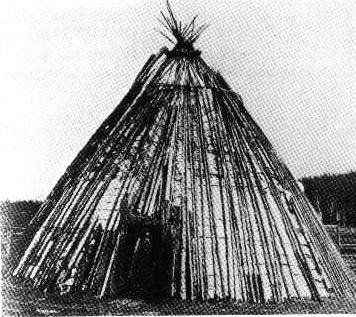 Paleolithic Siberian hunters were forced to abandon their spacious semi-
subterranean dwellings for lighter portable shelters by the warming of the
climate. A type of light surface dwelling such as a conical structure
covered with tree bark or skins is indicated by the remains unearthed at
campsites at the mouth of Malaya Munku River where it joins the Lena.
Paleolithic Siberian hunters were forced to abandon their spacious semi-
subterranean dwellings for lighter portable shelters by the warming of the
climate. A type of light surface dwelling such as a conical structure
covered with tree bark or skins is indicated by the remains unearthed at
campsites at the mouth of Malaya Munku River where it joins the Lena.
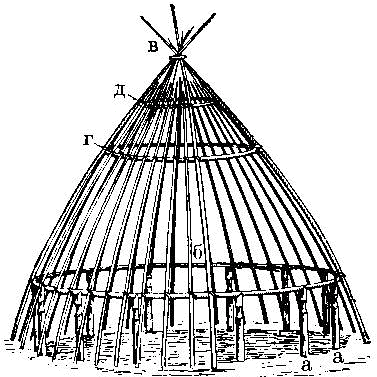
- Large Yakut conical birchbark summer tent similar to ancient Yakut Urasa.
- Frame of a Yakut conical dwelling.
The conical tent is dispersed over a vast area extending from Arkhangelsk in the west to the Omolon river in the east. It is found among the mountain peoples of the Sayan region, the independent peoples along the Yenisey, the southern Turkish peoples, the cattle and deer herding Yakuts, Tungus-Manchurian peoples, all the Evenki and Eveni groups and some Palaeo-Asiatic peoples. The conical tent is found in use among tribes who derive their livelihood by hunting or herding reindeer and who live in boreal forest areas for at least part of the year, and while the conical tent is widely associated with the reindeer Tungus, it is shared by Turks, Samoyed, Finn and some Northern Mongolian tribes.
- Khanti dwelling made from two single pitched roofed tents
- Keti double-hemispherical tent of bent arches.
- Khanti conical summer tent covered with birchbark.
- Khanti conical winter tent covered with hides.
The conical tent is essentially a primitive dwelling used by peoples at the hunting stage of culture. It is retained as a summer dwelling by many nomadic or semi-nomadic herders and even by some sedentary agricultural tribes. These tents may have provided the prototypes for tents in North-Eastern Europe and North America.
- Skin tent of the Upper Kolma Yukaghir.
- Summer village of the Yassachnaya Yukaghir on the Yassachnaya River.
The construction of the pole frame and the material used to cover it, but not the form, is exceptionally uniform throughout Siberia. The most significant differences are the types of primary support structure, the method of securing the upper ends of the poles at the peak, the type of frame used to suspend the cooking vessels over the hearth and its degree of integration with the primary support structure and the material pattern and means of securing the tent sheet to the frame.
- Nentsi conical tent construction: Plan of summer tent.
- Top fastening of the foundation frame.
- Plan of winter tent; i, hearth, ii, planking shelf, iii, mat floor.
- Covers.
- Raising the covers.
- Section through tent.
- Smoke flap.
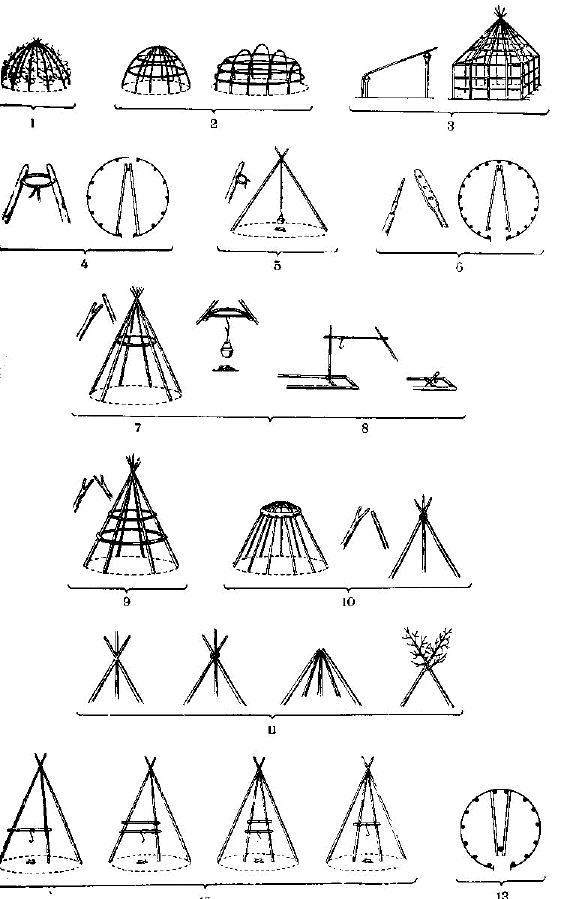 The types of tent covers used differ between Northern and Southern
Siberia: in the north three separate strips of soft tanned reindeer skins
are fastened to the poles with leather thongs and in the south the frame
is covered with birch bark softened by boiling before it is sewn together.
The cooking frame used for suspending kettles and pots over the central
hearth is rarely encountered outside Siberia.
The types of tent covers used differ between Northern and Southern
Siberia: in the north three separate strips of soft tanned reindeer skins
are fastened to the poles with leather thongs and in the south the frame
is covered with birch bark softened by boiling before it is sewn together.
The cooking frame used for suspending kettles and pots over the central
hearth is rarely encountered outside Siberia.
- Basic features of Siberian conical tents.
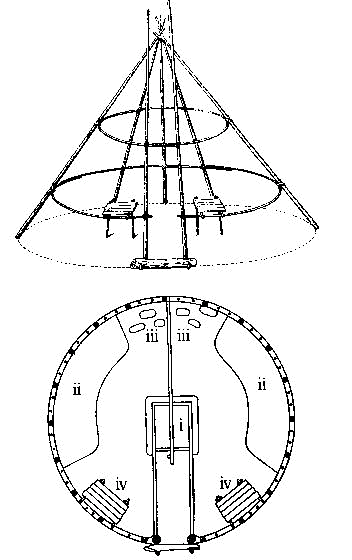 The support structure of the Keti is of particular interest because it
consists of a two- pole foundation with two additional poles, one on
either side of the entrance, a single pole at the back and two rings, one
at bench height and another at head height.
The support structure of the Keti is of particular interest because it
consists of a two- pole foundation with two additional poles, one on
either side of the entrance, a single pole at the back and two rings, one
at bench height and another at head height.
- Keti conical tent: frame;
- Plan: i, hearth, ii, sleeping places, iii, storage for household equipment, iv, storage for cooking utensils.
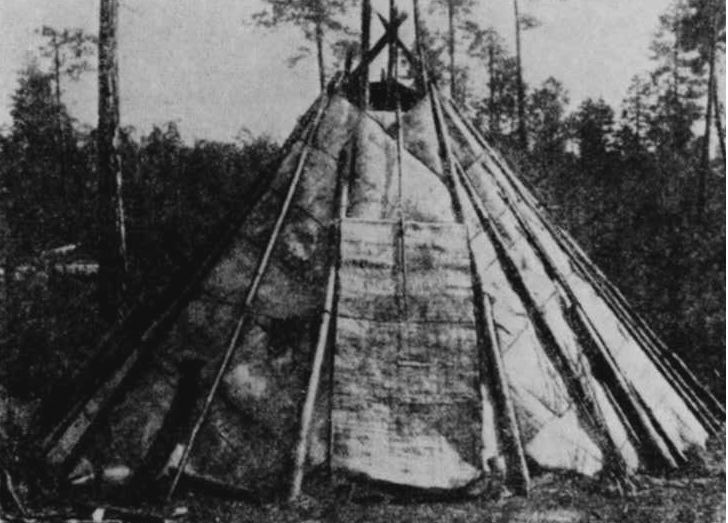 The entrance and back pole arrangement of the Keti tent frame is
reminiscent of the Lapp arch-post conical tent. Intermediate rings are
also found in the western type Eskimo tent.
The entrance and back pole arrangement of the Keti tent frame is
reminiscent of the Lapp arch-post conical tent. Intermediate rings are
also found in the western type Eskimo tent.
- Keti conical tent.
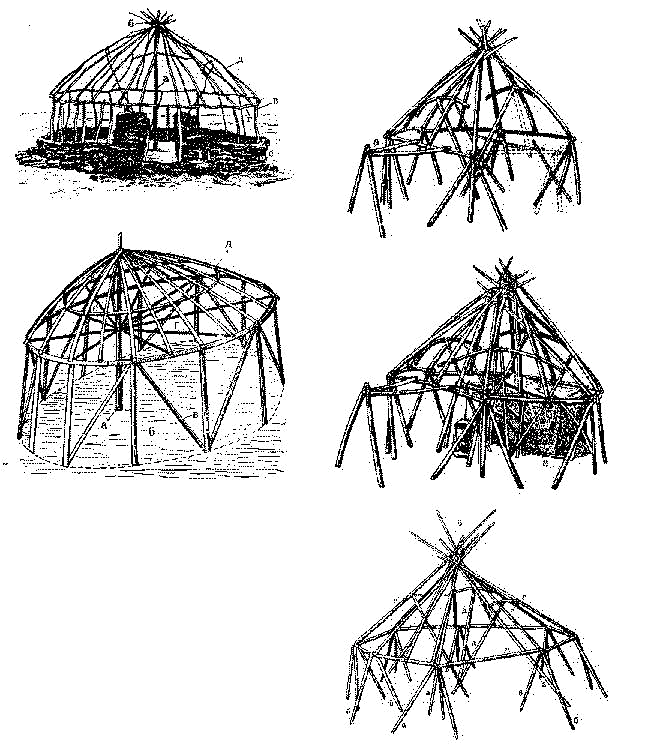 Cylindro-conical or compound tents are a natural development of conical tents.
More than half of the compound tents in Northeastern Siberia belong to two
Siberian Americanoid peoples, the Chukchee and Koryaks, deer herders, who form
a single ethnic group with a common origin. Being isolated their tents developed
independently from those that are related to the Mongolian type.
Cylindro-conical or compound tents are a natural development of conical tents.
More than half of the compound tents in Northeastern Siberia belong to two
Siberian Americanoid peoples, the Chukchee and Koryaks, deer herders, who form
a single ethnic group with a common origin. Being isolated their tents developed
independently from those that are related to the Mongolian type.
- Chukchee cylindrical compound tent.
- Chukchee and Asiatic Eskimo cylindrical compound tent.
- Heavily framed Koryak polygonal compound tent.
- Heavily framed Koryak polygonal compound tent.
- Reindeer Chukchee octagonal compound tent.
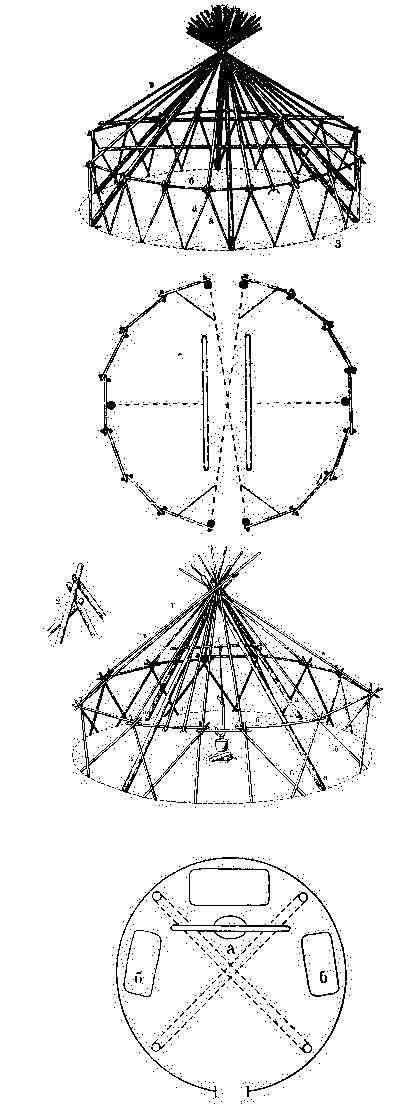 A central foundation structure of from four to six poles is retained in
the tents belonging to the Eveni. These are notably more advanced and this
is particularly apparent in the rationalized wall framing which
anticipates the lattice wall of the Turkic and Mongolian compound tents.
A central foundation structure of from four to six poles is retained in
the tents belonging to the Eveni. These are notably more advanced and this
is particularly apparent in the rationalized wall framing which
anticipates the lattice wall of the Turkic and Mongolian compound tents.
- Portable winter tent of the Eveni; frame.
- Plan.
- Portable cylindrical tent of the Eveni of the Markovsk region; frame.
- Plan.
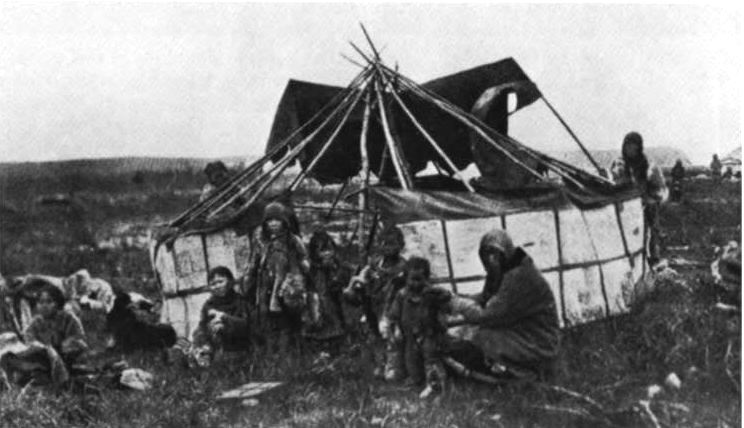
- Tent of the Upper Kolyma Tungus.
The Northeastern Siberian compound tents are covered with reindeer
skins and occasionally with birchbark, the winter tents of the Chuckchee
and Koryak are sheathed with heavy reindeer skins, and those of the Eveni
and Tundra Yukaghir are invariably covered with dressed skins without the
hair.
If the Lapps are an off-shoot of the Samoyed or Ugrian tribes of Siberia then it is likely that their conical tents derived from a Samoyed or Siberian prototype. The conical Lapp tents have many features in common with Siberian tents and these similarities are particularly marked in the arched-post and Keti conical tents.
- Lapp conical tent.
- The Lapp tent with storage poles in the background.
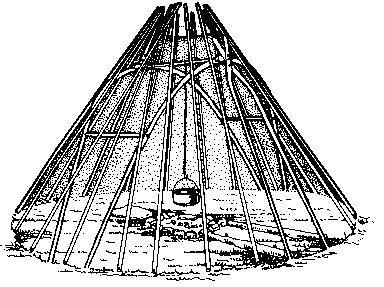
The Scandinavian Lapps to the west of Siberia use two types of conical tent. The conical Lapp tent incorporates a three-pole foundation found all over the arctic, but the arched-post conical tent peculiar to the fully nomadic Lapps, has a remarkable support structure consisting of two pairs of curved poles forming arches and connected by a ridge pole and cross braces.
- Framework of a Lapp arched-post tent
